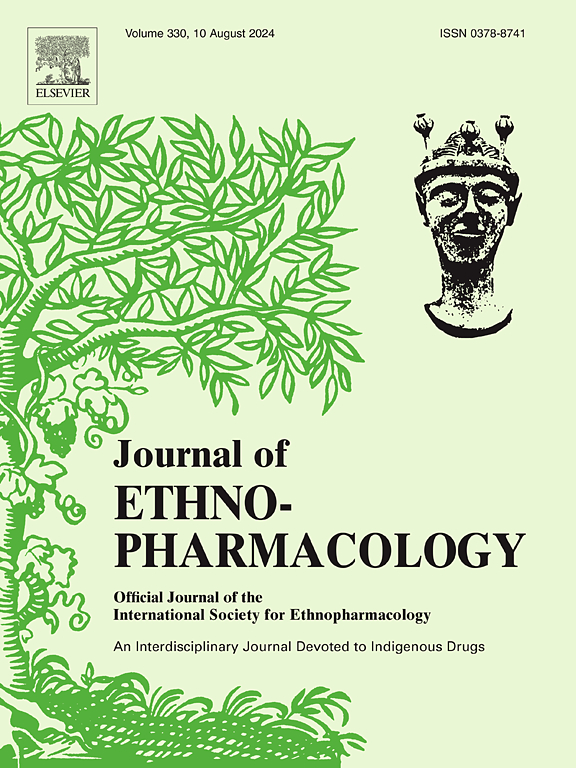Integrating metabolomics and network pharmacology analysis provides new insights into the lipid metabolism disorder of Abrus mollis
IF 4.8
2区 医学
Q1 CHEMISTRY, MEDICINAL
引用次数: 0
Abstract
Ethnopharmacological relevance
Abrus mollis Hance (AM), a traditional medicinal used for hepatoprotection in the south of China, has demonstrated potential in ameliorating lipid metabolism disorders (LMD). However, the underlying mechanisms remain elusive.
Aim of the study
To explore the mechanisms by which AM regulates lipid metabolism in mice on a high-fat diet through integrated metabolomics and network pharmacology.
Materials and methods
An HFD-induced dyslipidemia mice model was established to evaluate the therapeutic effectiveness of AM. Untargeted metabolomics identified hepatic endogenous metabolites and associated pathways. Ultra-performance liquid chromatography-quadrupole time-of-flight mass spectrometry (UPLC-Q-TOF/MS) characterized bioactive compounds and blood-absorbed components in AM. Network pharmacology analysis of blood-absorbed components, combined with molecular docking, predicted potential active constituents targeting lipid metabolism disorders, identified critical targets, and mapped metabolic pathways. Core regulatory mechanisms were elucidated through integrative analysis of network pharmacology predictions and metabolomics data. Transcriptional levels and protein expression of related genes were analyzed in murine hepatic tissues using real-time quantitative PCR (RT-qPCR) and Western blotting.
Results
Animal experiments had confirmed the efficacy of AM in alleviating lipid abnormalities induced by HFD. Twenty-one hepatic endogenous metabolites were identified, with major pathways encompassing arachidonic acid metabolism, linoleic acid metabolism, among others. UPLC-Q-TOF/MS analysis characterized 50 bioactive compounds in AM, 24 of which were detected in plasma. Network pharmacology prioritized schaftoside, hyperoside, protocatechuic acid, and vitexin as core components targeting TP53, SRC, ESR1, and PIK3CA, while molecular docking validated their strong binding affinities. KEGG analyses indicated that the PI3K-Akt signaling pathway acts as the core regulatory pathway which was further confirmed by integrated of metabolomics and network pharmacology analyses. Subsequent RT-qPCR and WB further evidenced AM-mediated downregulation of PI3K/Akt pathways-associated transcription factors and proteins.
Conclusion
This study elucidated the multi-target mechanisms of AM via the PI3K/Akt signaling pathway and highlighted its therapeutic potential in modulating lipid metabolism disorders.

结合代谢组学和网络药理学分析,为研究青霉脂质代谢紊乱提供了新的思路。
民族药理学相关性:中国南方用于保肝的传统药物Abrus mollis Hance (AM)已被证明具有改善脂质代谢紊乱(LMD)的潜力。然而,潜在的机制仍然难以捉摸。研究目的:通过代谢组学和网络药理学的结合,探讨AM如何调节高脂饮食(HFD)诱导小鼠的脂质代谢。材料与方法:建立hfd致血脂异常小鼠模型,评价AM的治疗效果。非靶向代谢组学鉴定了肝脏内源性代谢物和相关途径。超高效液相色谱-四极杆飞行时间质谱(UPLC-Q-TOF/MS)表征AM中的生物活性成分和血吸收成分。血液吸收成分的网络药理学分析,结合分子对接,预测针对脂质代谢紊乱的潜在活性成分,识别关键靶点,绘制代谢途径。通过对网络药理学预测和代谢组学数据的综合分析,阐明了核心调控机制。采用实时定量PCR (RT-qPCR)和Western blotting分析小鼠肝组织中相关基因的转录水平和蛋白表达。结果:动物实验证实AM对HFD引起的脂质异常有缓解作用。鉴定出21种肝脏内源性代谢物,主要途径包括花生四烯酸代谢、亚油酸代谢等。UPLC-Q-TOF/MS分析鉴定了AM中50种生物活性化合物,其中24种在血浆中检测到。网络药理学将沙花苷、金丝桃苷、原儿茶酸和牡荆素作为靶向TP53、SRC、ESR1和PIK3CA的核心成分,通过分子对接验证了它们较强的结合亲和力。KEGG分析最终表明PI3K-Akt信号通路是关键通路。代谢组学和网络药理学数据的综合分析进一步证实了PI3K/Akt信号通路是核心调控通路。RT-qPCR和WB进一步证实am介导的PI3K/Akt通路相关转录因子和蛋白的下调。结论:本研究阐明了AM通过PI3K/Akt信号通路的多靶点机制,突出了AM在调节脂质代谢紊乱中的治疗潜力。
本文章由计算机程序翻译,如有差异,请以英文原文为准。
求助全文
约1分钟内获得全文
求助全文
来源期刊

Journal of ethnopharmacology
医学-全科医学与补充医学
CiteScore
10.30
自引率
5.60%
发文量
967
审稿时长
77 days
期刊介绍:
The Journal of Ethnopharmacology is dedicated to the exchange of information and understandings about people''s use of plants, fungi, animals, microorganisms and minerals and their biological and pharmacological effects based on the principles established through international conventions. Early people confronted with illness and disease, discovered a wealth of useful therapeutic agents in the plant and animal kingdoms. The empirical knowledge of these medicinal substances and their toxic potential was passed on by oral tradition and sometimes recorded in herbals and other texts on materia medica. Many valuable drugs of today (e.g., atropine, ephedrine, tubocurarine, digoxin, reserpine) came into use through the study of indigenous remedies. Chemists continue to use plant-derived drugs (e.g., morphine, taxol, physostigmine, quinidine, emetine) as prototypes in their attempts to develop more effective and less toxic medicinals.
 求助内容:
求助内容: 应助结果提醒方式:
应助结果提醒方式:


